













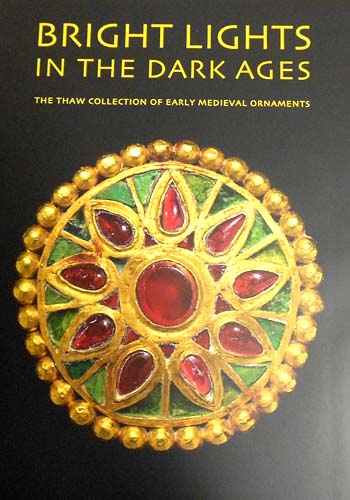
Bright Lights in the Dark Ages: The Thaw Collection of Early Medieval Ornaments by Noel Adams.
NOTE: We have 75,000 books in our library, almost 10,000 different titles. Odds are we have other copies of this same title in varying conditions, some less expensive, some better condition. We might also have different editions as well (some paperback, some hardcover, oftentimes international editions). If you don’t see what you want, please contact us and ask. We’re happy to send you a summary of the differing conditions and prices we may have for the same title.
DESCRIPTION: Massive hardcover with dustjacket.. Publisher: Giles (2014). Pages: 408. Size: 12½ x 9¼ x 1½ inches; 6 pounds.. “Bright Lights of the Dark Ages” is a major new volume on early Medieval art. It features over two hundred stunning and extremely rare early medieval gold and precious stonework objects, including brooches, buckles, shields, clasps, spoons and other “grave goods”, that were interred as status symbols with their owners in burials mounds across Europe.
The new societies of the early Medieval period which developed on the periphery of the great Roman Empire – Germanic barbarians in western Europe, Sarmatian and later Alanic tribes around the Black Sea, and the eastern frontier cities bordering the Parthian Empire in Iran – were all shaped by interaction with the Roman Empire, and profoundly influenced by its material culture.
Author Noël Adams surveys the magnificent pieces that were made to advertise power and wealth in these new “barbarian” kingdoms which arose after the fall of the Roman Empire, and in doing so shows the dramatic and surprising relationship between these “migration era” objects and later medieval art. In a volume full of wonderful images, highlights include Gothic and Visigothic imperial style brooches from modern-day Slovakia and Crimea, superb Gallo-Roman spoons and enameled domed brooches and buckles from Northern Europe and Britain.
CONDITION: NEW. MASSIVE new hardcover w/dustjacket. Giles (2014) 408 pages. Unblemished and pristine in every respect. Pages are clean, crisp, unmarked, unmutilated, tightly bound, unambiguously unread. Satisfaction unconditionally guaranteed. In stock, ready to ship. No disappointments, no excuses. PROMPT SHIPPING! HEAVILY PADDED, DAMAGE-FREE PACKAGING! #8321a.
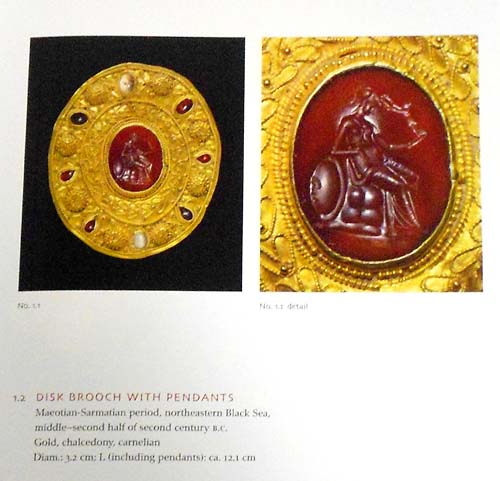
PLEASE SEE DESCRIPTIONS AND IMAGES BELOW FOR DETAILED REVIEWS AND FOR PAGES OF PICTURES FROM INSIDE OF BOOK.
PLEASE SEE PUBLISHER, PROFESSIONAL, AND READER REVIEWS BELOW.
PUBLISHER REVIEWS:
REVIEW: “Bright Lights of the Dark Ages” is a major new volume focused on early Medieval personal ornament. It features over one hundred magnificent objects, many crafted in gold and silver and inlaid with sparkling garnet stones. These splendid brooches, buckles, and pendants, created to advertise power and wealth in the barbarian kingdoms, were later interred with their owners to be used in the afterlife.
The exceptionally broad scope of the Thaw collection, spanning over a millennium, illustrates the continuity and evolution of fine metalworking traditions. It also reveals the profound influence of the classical world on the new political alliances formed during the early Medieval period that united people from diverse cultural and ethnic backgrounds. Groups of Iranian Sarmatians and Alans, Turkic tribes from the east, and Germanic and Slavic barbarians in western Europe were all shaped by their interaction with the Roman and Byzantine empires.
Highlights of this volume, replete with sumptuous images, include stunning brooches from the Sarmatian period, rare examples of Hunnic and Gothic garnet cloisonné, exceptional brooches from the Merovingian period, and superb Gallo-Roman enameled brooches and spoons.
REVIEW: Bright Lights of the Dark Ages is a major new volume on early Medieval art. It features over two hundred stunning and extremely rare early medieval gold and precious-stonework objects, including brooches, buckles, shields, clasps, spoons, and other “grave goods,” that were interred as status symbols with their owners in burials mounds across Europe.
The new societies of the early Medieval period that developed on the periphery of the great Roman Empire—Germanic barbarians in western Europe, Sarmatian and later Alanic tribes around the Black Sea, and the eastern-frontier cities bordering the Parthian Empire in Iran―were all shaped by interaction with the Roman Empire and profoundly influenced by its material culture.
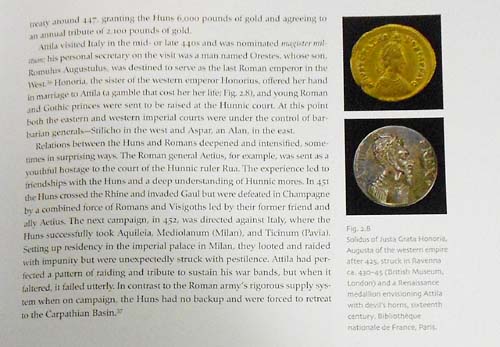
Author Noël Adams surveys the magnificent pieces that were made to advertise power and wealth in these new “barbarian” kingdoms that arose after the fall of the Roman Empire and in doing so shows the dramatic and surprising relationship between these “migration era” objects and later medieval art. In a volume full of wonderful images, highlights include Gothic and Visigothic imperial- style brooches from modern-day Slovakia and Crimea, superb Gallo-Roman spoons and enameled domed brooches, and buckles from Northern Europe and Britain. Photographer John Bigelow Taylor's images of Thaw Collection works render these archaeological finds in exquisite detail capturing the intricacies of their materials and craftsmanship.
REVIEW: Dr. Noël Adams is currently Administrator and Deputy Curator of the Furusiyya Art Foundation. She publishes widely on material culture of the first millennium A.D. and has co-edited and contributed papers to the British Museum Research Publication series, most recently: “Recent Research on Byzantine Jewelry” (2010) and “Gems of Heaven: Recent Research on Engraved Gemstones in Late Antiquity, AD 200–600” (2011). Dr. Adams has organized exhibitions at the National Trust Visitor Centre at Sutton Hoo, the British Museum, and the Morgan Library & Museum in New York.
PROFESSIONAL REVIEWS:
REVIEW: “Bright Lights in the Dark Ages” is the seventh volume in which the Morgan Library and Museum documents a segment of the Eugene Thaw collection. Thaw’s many collections have been assembled over a lifetime, and he is considered the museum’s greatest benefactor since J.P. “Pierpont” Morgan himself. Art collector and dealer Eugene Thaw began acquiring ornaments from the early medieval period in the 1980s, leading to a systematic effort in 2001 to bridge the gap between the Museum’s ancient collections and its late medieval holdings. Thaw’s choices were based on aesthetic rather than scholarly merit, and he was advised on his acquisitions by the author of this book.

This volume focuses on small personal ornaments (brooches, buckles, and pendants), from Western Europe, including the United Kingdom and Scandinavia, to the Black Sea, that were fabricated in the early Middle Ages, often referred to as the “Dark Ages.” These small objects, often found interred with their owner in gravesites, are considered “portable wealth” and are usually interpreted by historians and archeologists as emblems of power and status.
The book’s narrow focus allows the author to address two objectives. The first is to challenge the preconceptions of art and culture of the “Dark Ages,” and the pejorative use of that term to describe a time that was actually quite culturally dynamic. The second is to demonstrate the continuity and evolution of metalworking from the 2nd century to the 10th century AD. To provide helpful context, the introductory sections outline the declining Roman Empire, the migration and invasion of new peoples and tribes from the East and the North, and the contraction of the Byzantine Empire.
The term “Dark Ages” refers to the death of classical literature in the sense that pagan tribes, specifically Germanic and Slavic “barbarians,” had rich oral traditions that eclipsed the written word following the disintegration of the Roman Empire. Other scholars of the 14th century regarded the dearth of written history, building activity, and artistic output as an indication of a “dark” time in history. Even today, “Hun,” “Goth,” “barbarian,” and, to a lesser degree, “Middle Ages” have negative connotations. Yet the barbarians and nomads, dismissed by the Greeks and Romans as having no culture or heritage, did recognize the sophistication of the Romans and sought to incorporate aspects of their culture, including classical forms and realistic imagery. In the 20th century, some scholars attempted to discontinue the pejorative use of “Dark Ages” and “barbarian,” promoting for a time the use of “migration period,” but the appellation and connotation appears to have been thoroughly embedded. The title of the volume seeks to challenge that preconception and to point out that all was not “dark” in this historical era.
The book features more than 100 examples of personal ornaments from this period from the Thaw collection, including fine metal, inlay, cloisonné, and mounted gemstones. The pieces were collected as singles and not as part of a grave burial collection. Through extrapolation from similar objects interpreted in a grave context, the pieces can be assigned to specific periods and regions. In interpreting the significance and meaning of the objects, Adams admits to having “committed one of the graver sins for the archeologist—the purposeful mixing of different types of evidence” in having used historical information to explain archeological findings and vice versa. The result, however, is a coherent narrative in which the reader can understand the significance and the sequence of the featured objects in an appropriate framework.
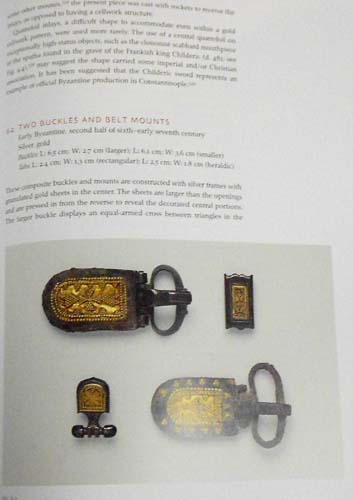
Following the introduction are six chapters examining different facets of the migration and invasions that bridged the transformation of Western Europe from a Greco-Roman world to the modern nation-states. The chapter introductions weave together history and cultural shifts (illustrated with maps), theories of visual art and personal adornment, and the state of craftsmanship/technology. Examples from other collections are included to better illustrate concepts. The remainder of the chapter is devoted to examples from the Thaw collection. Each is illustrated by a large-scale photo plus detail views. For those wanting technical details, the gemstones are identified and the jewelry making techniques are described. The stylistic attributes are discussed and the placement of the piece in its historical and cultural context is elaborated on, usually referencing other documented pieces. The photography and description are detailed enough to inspire and serve as a guide for a contemporary jeweler to design or manufacture archeological “revival” pieces that vastly differ from the Renaissance, Etruscan, or Egyptian objects associated with medieval influence.
The book ends rather abruptly, in the style of a catalog. The glossary could be more extensive, being dominated by geographic and historical periods rather than jewelry and stylistic terms. The bibliography attests ultimately to the scholarly nature of this work—it is an overwhelming 50 pages.
Trained as a geologist, art historian, and archeologist, Noël Adams brings her unique scholarly perspective to the technological aspects of metalwork. Less attention is paid to historiography, historical gender studies, cemetery analysis, dating analysis, and anthropological interpretations of burial ritual. The body of historical knowledge is augmented by examining how the pieces were physically made and the origin of materials, though one can only speculate how pieces were commissioned, supplied, bought and sold, or their meanings.
One favorite of Adams that was unfamiliar to me was “garnet cloisonné” or “framework cloisonné,” where garnets or glass pieces are collet set, giving the appearance of fired glass enamel. She defines this technique as “cold cloisonné” in the glossary. Examples are given of its evolution through Hunnic, Visigothic, and Merovingian periods of the 5th and 6th centuries.
I enjoyed this book because it gently made me aware of my own preconceived notions about the so-called “Dark Ages,” and then dispelled those notions. The early medieval period is one of the most complex in history—transitioning from long-established cultures of the Roman and Byzantine Empires to domination and displacement by very different peoples. The resulting turmoil eventually settled into an era of assimilation and comingling that would set the stage for a new era of creativity and progress, the “high” Middle Ages that eventually led to the Renaissance. In the introductory sections, the historical and cultural context is presented with just enough information to keep the interest of the average reader. Some of the chapters go into a level of historic detail that may be overwhelming to some, but gemological or jewelry enthusiasts can be satisfied by skipping to sections and illustrations focusing on medieval techniques and styles. Overall, Bright Lights in the Dark Ages is a worthwhile read.

REVIEW: “Bright Lights of the Dark Ages” is a major new volume on early Medieval art. It features over two hundred stunning and extremely rare early medieval gold and precious stonework objects, including brooches, buckles, shields, clasps, spoons and other "grave goods", that were interred as status symbols with their owners in burials mounds across Europe.
The new societies of the early Medieval period which developed on the periphery of the great Roman Empire – Germanic barbarians in western Europe, Sarmatian and later Alanic tribes around the Black Sea, and the eastern frontier cities bordering the Parthian Empire in Iran – were all shaped by interaction with the Roman Empire, and profoundly influenced by its material culture.
Author Noël Adams surveys the magnificent pieces that were made to advertise power and wealth in these new "barbarian" kingdoms which arose after the fall of the Roman Empire, and in doing so shows the dramatic and surprising relationship between these "migration era" objects and later medieval art. In a volume full of wonderful images, highlights include Gothic and Visigothic imperial style brooches from modern-day Slovakia and Crimea, superb Gallo-Roman spoons and enameled domed brooches and buckles from Northern Europe and Britain.
REVIEW: “Bright Lights in the Dark Ages” is a major new volume focused on Early Medieval personal ornament. It features over one hundred magnificent objects, many crafted in gold and silver and inlaid with sparkling garnet stones. These splendid brooches, buckles, and pendants, created to advertise power and wealth in the barbarian kingdoms, were later interred with their owners to be used in the afterlife.
The exceptionally broad scope of the Thaw collection, spanning over a millennium, illustrates the continuity and evolution of fine metalworking traditions. It also reveals the profound influence of the classical world on the new political alliances formed during the Early Medieval period that united people from diverse cultural and ethnic backgrounds.
Highlights of this volume, replete with sumptuous images, include stunning Sarmatian-period jewelry, rare examples of Hunnic and Gothic garnet cloisonne, and exceptional brooches from the Merovingian period as well as superb Early Byzantine gold belt fittings.
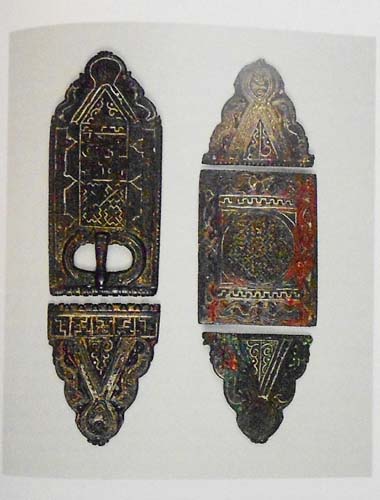
REVIEW: The Early Medieval period, often referred to as the Dark Ages and beginning in Europe around the year 400, has been popularly portrayed as a time when the refined aesthetics of the classical world fell prey to hosts of migrating peoples on the fringes of the Roman Empire.
However, a major new volume on Early Medieval art, “Bright Lights in the Dark Ages: The Thaw Collection of Early Medieval Ornaments”, written by Noël Adams and featuring photography by John Bigelow Taylor, challenges accepted orthodoxy about the art and culture of the era.
The more than one hundred magnificent objects in Bright Lights in the Dark Ages were created over a millennium, and often crafted in gold and silver inlaid with rare gems and stones. The volume presents them singly and together in hundreds of beautiful color photographs, with revealing commentary about the people who made them and their meaning and symbolism.
The objects were drawn from the Thaw Collection of Early Medieval Ornaments at the Morgan Library & Museum in New York City. Eugene V. Thaw is a Life Trustee and major benefactor of the Morgan, and an internationally renowned collector of drawings. His medieval ornaments collection is on exhibit in a specially designed gallery in the Morgan’s McKim building.
Among the everyday items represented in Bright Lights in the Dark Ages are brooches, buckles, pendants, and earrings. The volume demonstrates how the migrating peoples brought sophisticated metalworking traditions to the creation of these objects with clear influences from their interactions over the centuries with the Roman and Byzantine empires.
Among the highlights of the volume are exceptional examples of brooches from the Black Sea region, rare examples of Hunnic and Gothic garnet cloisonné from Germany, and superb Early Byzantine gold belt fittings.

“Bright Lights in the Dark Ages” is published by D Giles Limited, London, in association with the Morgan Library & Museum. Author Noël Adams publishes widely on material culture of the first millennium A.D. She has also organized exhibitions at the Morgan, the British Museum, and the National Trust Visitor Centre at Sutton Hoo. Photographer John Bigelow Taylor is noted for his work in fine art photography, and has produced more than 150 books ranging from the art and landscape of prehistoric Greece to the jewelry collection of famed Hollywood actress Elizabeth Taylor.
REVIEW: Features over 100 magnificent objects, many crafted in gold and silver and inlaid with sparkling garnet stones, created to advertise power and wealth in the barbarian kingdoms, and interred with their owners to be used in the afterlife.
REVIEW: An important new volume focused on early Medieval personal ornaments.
READER REVIEWS:
REVIEW: A beautiful ,historical book, with wide pages and clear pictures. The book is to document the importance of aesthetics for all the different ethnicities who lived in evolving post-Roman EurAsia. Much more impassioned with a historical point of view than the artistic. Highly recommend purchased if you want to 'know' as much as see.
REVIEW: Sumptuous with stunning photos, early medieval artefacts that are a true revelation, a must for those interested in the wonderful skill & techniques used in this period.
REVIEW: Brilliant book, beautifully illustrated and produced. Text informative and well written. Well done!
REVIEW: Five stars!!! Excellent book for research and just drooling over the photos.
I always ship books Media Mail in a padded mailer. This book is shipped FOR FREE via USPS INSURED media mail (“book rate”). All domestic shipments and most international shipments will include free USPS Delivery Confirmation (you might be able to update the status of your shipment on-line at the USPS Web Site) and free insurance coverage. A small percentage of international shipments may require an additional fee for tracking and/or delivery confirmation. If you are concerned about a little wear and tear to the book in transit, I would suggest a boxed shipment - it is an extra $1.00. Whether via padded mailer or box, we will give discounts for multiple purchases. International orders are welcome, but shipping costs are substantially higher.
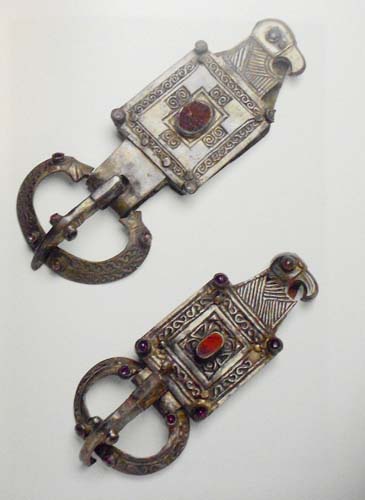
Most international orders cost an additional $12.99 to $33.99 for an insuredshipment in a heavily padded mailer, and typically includes some form of rudimentary tracking and/or delivery confirmation (though for some countries, this is only available at additional cost). However this book is quite heavy, and it is too large to fit into a flat rate mailer. Therefore the shipping costs are somewhat higher than what is otherwise ordinary. There is a discount program which can cut postage costs by 50% to 75% if you’re buying about half-a-dozen books or more (5 kilos+). Rates and available services vary a bit from country to country. You can email or message me for a shipping cost quote, but I assure you they are as reasonable as USPS rates allow, and if it turns out the rate is too high for your pocketbook, we will cancel the sale at your request. ADDITIONAL PURCHASES do receive a VERY LARGE discount, typically about $5 per book (for each additional book after the first) so as to reward you for the economies of combined shipping/insurance costs. Your purchase will ordinarily be shipped within 48 hours of payment. We package as well as anyone in the business, with lots of protective padding and containers.
All of our shipments are sent via insured mail so as to comply with PayPal requirements. We do NOT recommend uninsured shipments, and expressly disclaim any responsibility for the loss of an uninsured shipment. Unfortunately the contents of parcels are easily “lost” or misdelivered by postal employees – even in the USA. That’s why all of our domestic shipments (and most international) shipments include a USPS delivery confirmation tag; or are trackable or traceable, and all shipments (international and domestic) are insured. We do offer U.S. Postal Service Priority Mail, Registered Mail, and Express Mail for both international and domestic shipments, as well United Parcel Service (UPS) and Federal Express (Fed-Ex). Please ask for a rate quotation. We will accept whatever payment method you are most comfortable with. If upon receipt of the item you are disappointed for any reason whatever, I offer a no questions asked return policy. Send it back, I will give you a complete refund of the purchase price (less our original shipping costs).
Most of the items I offer come from the collection of a family friend who was active in the field of Archaeology for over forty years. However many of the items also come from purchases I make in Eastern Europe, India, and from the Levant (Eastern Mediterranean/Near East) from various institutions and dealers. Though I have always had an interest in archaeology, my own academic background was in sociology and cultural anthropology. After my retirement however, I found myself drawn to archaeology as well. Aside from my own personal collection, I have made extensive and frequent additions of my own via purchases on Ebay (of course), as well as many purchases from both dealers and institutions throughout the world - but especially in the Near East and in Eastern Europe. I spend over half of my year out of the United States, and have spent much of my life either in India or Eastern Europe. In fact much of what we generate on Yahoo, Amazon and Ebay goes to support The Hermitage Museum in St. Petersburg, as well as some other worthy institutions in Europe connected with Anthropology and Archaeology.
I acquire some small but interesting collections overseas from time-to-time, and have as well some duplicate items within my own collection which I occasionally decide to part with. Though I have a collection of ancient coins numbering in the tens of thousands, my primary interest is in ancient jewelry. My wife also is an active participant in the "business" of antique and ancient jewelry, and is from Russia. I would be happy to provide you with a certificate/guarantee of authenticity for any item you purchase from me. There is a $2 fee for mailing under separate cover. Whenever I am overseas I have made arrangements for purchases to be shipped out via domestic mail. If I am in the field, you may have to wait for a week or two for a COA to arrive via international air mail. But you can be sure your purchase will arrive properly packaged and promptly - even if I am absent. And when I am in a remote field location with merely a notebook computer, at times I am not able to access my email for a day or two, so be patient, I will always respond to every email. Please see our "ADDITIONAL TERMS OF SALE."


| |||||||||||||||||||||













